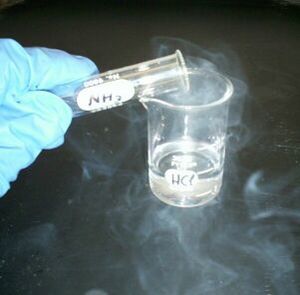Base (chemistry) facts for kids

A base is a type of chemical substance. It can accept a tiny particle called a hydrogen ion (H+) from another substance. Think of it like a catcher in baseball, ready to grab a proton. A chemical can do this if it has a negative charge or if it has special atoms like oxygen, nitrogen, or chlorine with extra electrons.
Just like acids, some bases are strong and some are weak. Weak bases are not very good at accepting these hydrogen ions. Strong bases, however, are very quick to grab them when they are mixed in water or with other chemicals.
A base is like the "chemical opposite" of an acid. An acid is a substance that gives away a hydrogen ion to a base.
Bases have a pH value greater than 7.0. This pH scale tells us how acidic or basic something is. Weak bases usually have a pH between 7 and 9. Strong bases have a pH value from 9 all the way up to 14.
Contents
How Bases Work
Bases are often used to neutralize acids. When a base, often a hydroxide ion (OH–), accepts a hydrogen ion from an acid, they form a harmless water molecule. This process is called neutralization. It happens when all the acids and bases react to make water and other neutral substances called salts. Acids can also be used to neutralize bases.
Every base has something called a "conjugate acid." This is formed when the base gains a hydrogen ion. For example, NH3 (ammonia) is a base. Its conjugate acid is the ammonium ion, NH4+. If a base is weak, its conjugate acid will be strong. If a base is strong, its conjugate acid will be weaker. Since ammonia is a moderately strong base, ammonium is a much weaker acid.
What Are Bases Like?
Bases have some special characteristics:
- They taste bitter. This is different from acids, which taste sour.
- They feel slimy or soapy when you touch them.
- They react with acids to create a salt solution.
- They turn red litmus paper blue. Litmus paper is a special paper used to test pH.
- They often contain metal oxides or hydroxides.
- Bases that can dissolve in water are called alkalis.
- Strong bases can react very strongly and dangerously with acids. A mild base can safely neutralize an acid spill.
You can find some common bases in your home. For example, lye and drain cleaners contain sodium hydroxide, which is a strong base. Ammonia, found in window and glass cleaners, is also a base. Other bases, like baking soda or cream of tartar, are used in cooking. These are not harmful and are safe to use in food.
Stronger bases are dangerous. You should never handle them without an adult's help. Always wear Gloves when working with bases. If a base touches your skin and causes irritation, rinse the area well with cold water. If the problem continues, get medical help right away.
Strong Bases You Should Know
A strong base is a base that releases a hydroxide ion (OH–) when it is put into water. Here are eight common strong bases:
- Lithium hydroxide (LiOH)
- Sodium hydroxide (NaOH)
- Potassium hydroxide (KOH)
- Rubidium hydroxide (RbOH)
- Cesium hydroxide (CsOH)
- Calcium hydroxide (Ca(OH)2)
- Strontium hydroxide (Sr(OH)2)
- Barium hydroxide (Ba(OH)2)
Cool Facts About Bases
- Your pancreas makes a fluid rich in the base bicarbonate. This helps to neutralize stomach acid before it reaches your small intestine.
- People take antacids to help with heartburn. Antacids contain a base that neutralizes the acid in the stomach.
- Bases can conduct electricity.
- A strong base that reacts well with acids is also known as an alkali.
- Lime is a base that farmers use to help neutralize soil that is too acidic.
- Bases are very good at getting stains out of fabrics.
- Rubbing a baking soda solution (which is a base) on an ant sting can help relieve the pain. This is because it neutralizes the formic acid in the sting.
Images for kids
-
Soaps are weak bases formed by the reaction of fatty acids with sodium hydroxide or potassium hydroxide.
See also
 In Spanish: Base (química) para niños
In Spanish: Base (química) para niños




